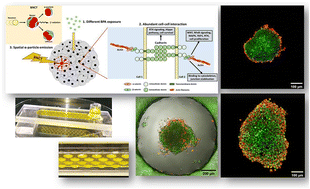Evaluating the biological effectiveness of boron neutron capture therapy by using microfluidics-based pancreatic tumor spheroids
Abstract
Background: The recent success of boron neutron capture therapy (BNCT) for cancer treatment has attracted considerable attention. Because irradiated neutrons penetrate deep into solid tumor tissue, BNCT efficacy is strongly influenced by cell pathophysiology in tumors. The tumor microenvironment critically influences tumor pathophysiology, but its effects on BNCT remain unexplored. Methods: We used a pancreatic tumor as a model to develop a high-throughput 3D tumor spheroid platform for evaluating BNCT efficacy under different microenvironment conditions. We expanded our system to serve as a transwell-like device in order to investigate the influence of stromal fibroblasts in the tumor microenvironment. Results: With the use of the proposed microfluidic chip and a laboratory pipette, more than 40 spheroids with controllable diameters (standard deviation <10%) could be cultured on a chip for more than 10 days. The response to BNCT from each spheroid can be monitored in real time. By using pancreatic tumor spheroids of two different diameters, we found that large spheroids, characterized by more hypoxic microenvironments, exhibited lower BNCT susceptibility. The cells in the hypoxic region expressed the HIF1-α signal, which is crucial in many therapeutic resistance signal pathways. In addition, the heterogeneous presence of stemness markers (Oct-4, Sox-2, and CD 44) implied that the underlying BNCT resistance mechanism was sophisticated. In the presence of fibroblasts, we found an association between β-catenin nuclear translocation and BNCT resistance; membrane contacts from fibroblasts were found to be indispensable for translocation activation. Conclusions: In summary, by means of easily accessible microfluidic engineering, we developed tumor spheroids to recapture the pathophysiological characteristics of pancreatic tumors. Our data suggest that hypoxia and fibrosis can reduce BNCT efficacy in pancreatic cancer treatment. Considering the growing requirement for drug screening in personalized medicine, our findings and the developed method are expected to improve the fundamental understanding of BNCT and facilitate broad applications of BNCT in clinical settings.



 Please wait while we load your content...
Please wait while we load your content...